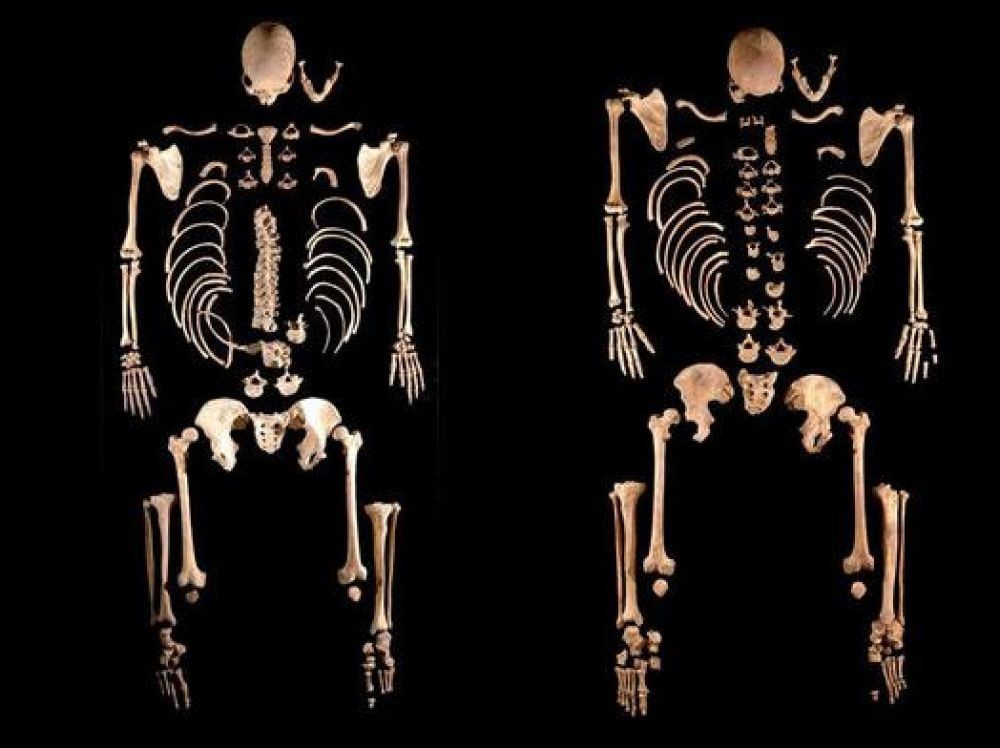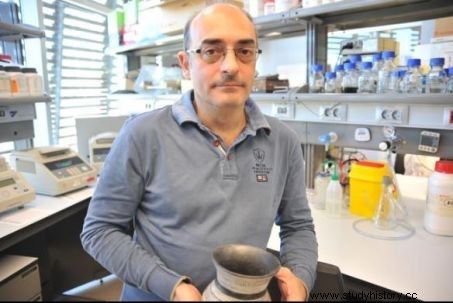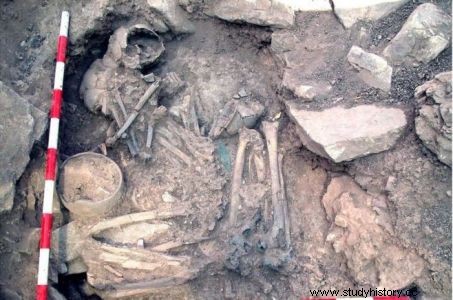An extensive genetic study offers new insights into the history of migratory movements in the Iberian Peninsula over the past 8000 years. Nomads from the steppes of Eastern Europe would have replaced a large part of the men.

Skeletons from La Brana, found in northwest Spain. These two brothers were closely linked to groups from Central Europe.
The researchers do not hide their surprise! If the Iberian Peninsula is known to have been a crossroads of settlement since the Paleolithic, no one expected it to have experienced such a large wave of migration...coming from the distant steppes of Eastern Europe. Even stronger, a major study published in the journal "Science" has just established that 4500 years ago, these populations replaced almost all the male lines of the peninsula! Conclusions established after the analysis of the ancient DNA of hundreds of bone samples by an international team of 111 paleogeneticists, co-led by Inigo Olalde and David Reich, of the Harvard University School of Medicine ( United States), as well as Carles Lalueza-Fox, of the Institute of Evolutionary Biology (CSIC/Pompeu Fabra University (UPF), in Barcelona (Spain). This impressive work traces an unprecedented picture of the settlement of the Iberian Peninsula in the over the past 8000 years.
To carry out this study, the researchers analyzed the genomes (complete set of genetic material found in the nuclei of cells) of 271 individuals who lived between 6000 BC and 1600 AD, from 79 sites. from Spain, Portugal, the Principality of Andorra and Gibraltar (Great Britain).
From 2500 years before our era, groups from Eastern Europe practically replaced all the men present in the Iberian Peninsula
And some results have not failed to amaze. Indeed, the lines of the Y chromosome - transmitted from father to son - that were found until then among the farmers of the peninsula at the end of the Neolithic period, would have gradually disappeared, replaced by a line (R1b-M269 ) from groups of farmers north of the Caspian Sea in present-day Russia. Thus it was in the Bronze Age, around 2500 BC, that the paternal ancestry of the Iberians, former occupants of the peninsula, would have begun to be remodeled in just four centuries. The analyzes indicate that the two groups, living side by side, would have largely hybridized. The archaeological archives having delivered no trace of particular violence at the arrival of these pastors from the steppe, the researchers hypothesize that the women of the peninsula, within the framework of alliances, would have favored the newcomers from Central Europe.
The researchers do not hide their surprise! If the Iberian Peninsula is famous for having been a crossroads of settlement since the Paleolithic, no one expected it to have experienced such a large wave of migration...coming from the distant steppes of Eastern Europe. Even stronger, a major study published in the journal "Science" has just established that 4500 years ago, these populations replaced almost all the male lines of the peninsula! Conclusions established after the analysis of the ancient DNA of hundreds of bone samples by an international team of 111 paleogeneticists, co-led by Inigo Olalde and David Reich, of the Harvard University School of Medicine ( United States), as well as Carles Lalueza-Fox, of the Institute of Evolutionary Biology (CSIC/Pompeu Fabra University (UPF), in Barcelona (Spain). This impressive work traces an unprecedented picture of the settlement of the Iberian Peninsula in the over the past 8000 years.
To carry out this study, the researchers analyzed the genomes (complete set of genetic material found in the nuclei of cells) of 271 individuals who lived between 6000 BC and 1600 AD, from 79 sites. from Spain, Portugal, the Principality of Andorra and Gibraltar (Great Britain).
From 2500 years before our era, groups from Eastern Europe practically replaced all the men present in the Iberian Peninsula
And some results have not failed to amaze. Indeed, the lines of the Y chromosome - transmitted from father to son - that were found until then among the farmers of the peninsula at the end of the Neolithic period, would have gradually disappeared, replaced by a line (R1b-M269 ) from groups of farmers north of the Caspian Sea in present-day Russia. Thus it was in the Bronze Age, around 2500 BC, that the paternal ancestry of the Iberians, former occupants of the peninsula, would have begun to be remodeled in just four centuries. The analyzes indicate that the two groups, living side by side, would have largely hybridized. The archaeological archives having delivered no trace of particular violence at the arrival of these pastors from the steppe, the researchers hypothesize that the women of the peninsula, within the framework of alliances, would have favored the newcomers from Central Europe.

Carles Lalueza-Fox, in the Paleogenomics Laboratory of the Institute of Evolutionary Biology of the UPF, in Barcelona (Spain).
"This change, which spanned 400 years, affected men and women unequally. It culminated at the end of the process in the almost complete replacement of the Y chromosomes of the Iberian male population of the Final Neolithic. By the Bronze Age, these new migrants had replaced 40% of the genetic heritage of the local population “, specifies Carles Lalueza-Fox, from the Paleogenomics Laboratory of the Institute of Evolutionary Biology, co-lead author of the study, joined by Sciences et Avenir. “In any case, this implies revisit the archaeological horizons of these eras with a different perspective “, adds the paleogeneticist.
The Basques would be genetically close to the inhabitants of 3000 years ago.
The analysis of this ancient DNA has also provided other information:the genetics of the current Basque population would have changed little since its origin located in the Iron Age, 3000 years ago. If the influence of the nomads of the steppe is also found among the Basques, there would have been little thereafter - unlike the other communities of the peninsula - of legacies of later migrants, such as the Romans, the Greeks, the Visigoths or Moors who arrived in the 8th th century. The geographical isolation of the Basques would be the reason. Another unexpected genetic discovery:considerable amounts of sub-Saharan genes were detected in two 4000-year-old individuals, one found in Madrid, the other in Gades (Cádiz), as well as a flow of genes from South Africa. north raised in the south-east of the peninsula during Punic and Roman times (between 20 BC and 400 AD), i.e. many centuries before the Muslim conquest of Hispania in 711.
Genetic data alone will not provide all the keys to population migrations, the researchers point out. "Other fields such as archeology and anthropology should be leveraged to understand what shaped these genetic patterns, continues Carlos Lalueza-Fox. What fascinated me most about this study was the discovery individual stories behind these big changes. Thus, the existence of a double tomb dated to the Bronze Age where a man of steppe origins and a local woman were together [Castillejo de Bonete (read framed ), Ed]; or this individual from North Africa who was buried in a site in Madrid 4,000 years ago; not to mention those people of Greek descent buried 2600 years ago at the other end of the Mediterranean, in the town of Empúries [Emporion, near Girona, in Catalonia, Ed]". When the "little" story sheds light on the big...

Tomb of Castillo de Bonete, in Ciudad Real (Spain). ©L.Benitez by Lugo Enrich - José Luis Fuentes Sanch
Mixed couple
At a Bronze Age site known as Castillejo de Bonete, in Ciudad Real, Spain, a woman and a man were found buried side by side. However, examinations have shown that the ancestry of the woman was entirely local, while the man, buried with an archer's bracelet on his forearm, had recent ancestors from central Europe. Everything therefore suggests that it was a mixed couple.
